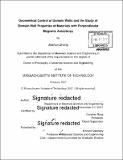Geometrical control of domain walls and the study of domain wall properties of materials with perpendicular magnetic anisotropy
Author(s)
Zhang, Jinshuo, Ph. D. Massachusetts Institute of Technology
DownloadFull printable version (15.47Mb)
Alternative title
Geometrical control of DWs and the study of DW properties of materials with PMA
Other Contributors
Massachusetts Institute of Technology. Department of Materials Science and Engineering.
Advisor
Caroline Ross.
Terms of use
Metadata
Show full item recordAbstract
Magnetic based devices such as hard disk drives (HDDs) are widely used in the computer industry because of their high memory capacity, non-volatility and low cost compared to semiconductor-based solid state disk drives (SSDs). However, they also suffer from low energy efficiency and low speed, due to the requirement for mechanical motion in order to access the data. In my thesis, I will first give a brief introduction to the motivation and background in the study of magnetic domain walls (DWs), which have attracted great attention due to their ability to be moved by field and/or current and corresponding potential applications in high speed memory or logic devices. I will then discuss how to geometrically control the behaviors of DWs in a ferromagnetic nanowire. I will first discuss how natural geometry distortions such as edge tapering from sputtering on an undercut resist profile and wire width variation from the patterning process would affect DW behavior, including static configurations, stability and dynamics under current pulsing. I will then discuss how similar geometrical effects will affect the properties of materials with perpendicular magnetic anisotropy (PMA). The same geometry modulation will have different effects depending on the origin of the PMA. Such results are confirmed by observing the magnetic reversal process. Besides the study on 180DWs, we will then discuss the field and current effects on 360 degree DWs (360DWs), which have many unique properties compared to 180DWs and are an alternative candidate for DW based devices. I will then discuss control of 360DW behavior by designing a geometrical heterostructure. We have found that by utilizing the asymmetric Oersted field originated from the heterostructure, we are able to control the 360DWs depending on their chirality. The structure can function as a 360DW chirality filter, which provides extra freedom in DW-based applications. These studies were conducted by a combination of micromagnetic simulations and experimental implementations. Techniques being used including OOMMF micromagnetic simulations, Comsolfinite element simulations, electrical measurements, magnetic force microscopy and other characterization techniques.
Description
Thesis: Ph. D., Massachusetts Institute of Technology, Department of Materials Science and Engineering, 2017. Cataloged from PDF version of thesis. Includes bibliographical references (pages 155-168).
Date issued
2017Department
Massachusetts Institute of Technology. Department of Materials Science and EngineeringPublisher
Massachusetts Institute of Technology
Keywords
Materials Science and Engineering.